Bee Stings And Dogs
Updated: February 2025
I really love bees – and dogs. But no doubt about it, a bee sting for a dog can be painful (as can wasp and hornet stings), so what are the signs of your dog being stung, how should you treat a dog for a bee sting, and when is a sting dangerous for a dog?
Risks And Signs Of Possible Bee Stings
 Bee stings and dogs - our spaniel sitting in the garden by the flowers.
Bee stings and dogs - our spaniel sitting in the garden by the flowers.Upon being stung, you may hear a yelp and your dog may paw at their muzzle or face, or begin to limp or bite at a paw.
Because
dogs often walk through grassy wild flower areas (including low growing wild flowers
such as clover and bird’s foot trefoil) they are most likely to be stung on the
paw or leg, or (if they frequently have their nose to the ground) around the
muzzle or face.
If you see your dog ‘biting’ at insects, try to discourage this, because it’s possible a sting could occur in the mouth.
When is a bee sting dangerous for a dog and when should they see the vet?
1. Bee sting on a dog’s nose, close to the eye, in the ear, in the mouth, close to the rectum
If your dog
is stung in any of the areas listed above, take it to the vet sooner rather
than later.
Stings around such areas can
be problematic in a variety of different ways. Serious reactions can occur
(such as swelling and breathing restrictions), and it would be better to have a
vet look at it and provide appropriate medication to prevent something more
serious and even life threatening.
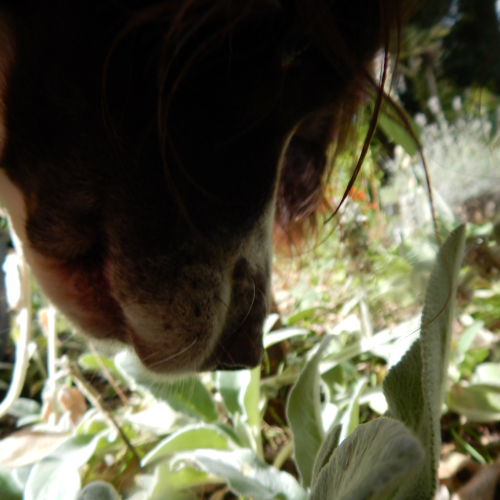 Our spaniel, Charlie sticking his nose into the Lamb's ear. The Lamb's ear is visited by bees, but Charlie was looking for frogs.
Our spaniel, Charlie sticking his nose into the Lamb's ear. The Lamb's ear is visited by bees, but Charlie was looking for frogs.2. Serious reactions
See your
vet immediately if your dog shows any of these signs (but not necessarily all
of them):
- difficulty breathing,
- vomiting and/or diarrhea (with blood sometimes present),
- severe swelling,
- drooling, or
- collapse.
Your dog is having a severe reaction – anaphylactic shock that could be life
threatening.
Your vet will provide the
necessary urgent treatment and support, and may provide you with an Epi-pen for
your dog in case of future stinging incidents.
3. Multiple stings
If your dog has been stung multiple times, see the vet for medication and advice immediately in case of reaction to multiple ‘injections’ of the venom (such as kidney failure).
Helping Dogs With Bee Stings
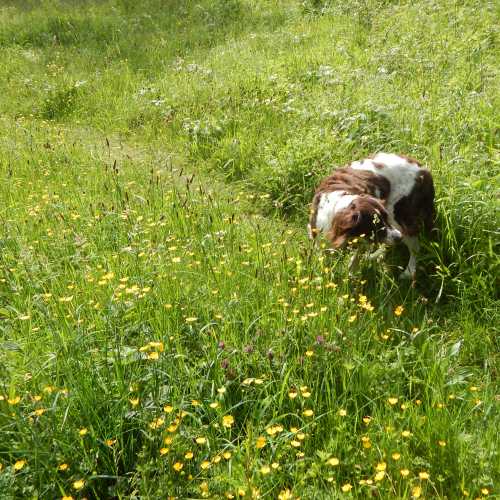 Our spaniel Charlie, among the wildflowers - it's the kind of environment where dogs can easily be stung (fortunately, this never happened to our dog).
Our spaniel Charlie, among the wildflowers - it's the kind of environment where dogs can easily be stung (fortunately, this never happened to our dog).If the reaction to the sting is not severe or on one of the locations described above, then you can help your dog yourself.
Do not give human medications to dogs unless instructed by a veterinarian, and monitor your dog incase of delayed reactions either to the sting or any home remedies.
If in doubt, always check with your vet!
Bee sting on the body or leg of a dog
If a dog is stung on the body – for example, its back or side, or if it is stung on the side of its leg, you could help your dog by taking measures to relieve the pain.
An ice pack on the area of the sting will help. If the stinger is still present within the skin and you are able to remove it, do so.
If you have bicarbonate of soda, mix a teaspoon with a few drops of water at a time until you have a paste. Apply the paste to the sting, and cover with a bandage if possible to prevent your dog licking the paste off.
Your dog may be irritated by the sting for a couple of days or so, and there may be a small amount of swelling in the area, but the effects will gradually wear off.
Sting between the toes/underside of paw
First try the treatments above, but keep an eye on your dog for reactions.
If your dog begins to bite at the paw and cause bleeding, there could be a danger of infection, in which case, speak with your vet about the best actions to take.
Are bee stings in dogs a common occurrence?
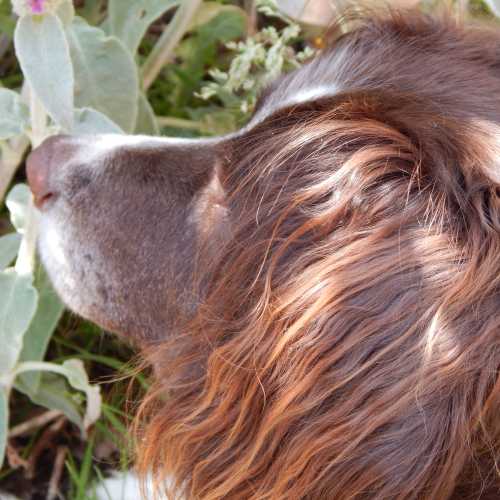 Beautiful Charlie.
Beautiful Charlie.I should point out that a dog being stung by a bee is certainly possible, so it’s a good idea to be aware of the signs and symptoms, but I’m not sure it’s something to be unduly worried about. Many dogs go for walks in parks, and don’t get stung.
The photographs of the dog on this page are of our lovely spaniel, Charlie, an ex-rescue, who came to us in 2011. We think he was about 8 years old when we got him (there were no formal records for him), and sadly he passed away in March 2019, but he had a very happy life with us, and we still love and miss him greatly.
Having a dog never deterred me from my efforts to attract bees into my garden, even though I knew a sting could be possible. He was never stung by a bee, wasp or hornet, despite the freedom he had in our garden, and the long country walks, including around wild flower areas where I would pause to photograph bees.
However, I would certainly keep dogs away from swarms, bee hives, wild honey bee colonies, bee nests, wasp and hornet nests.
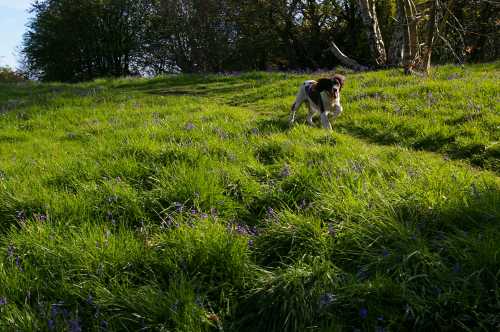
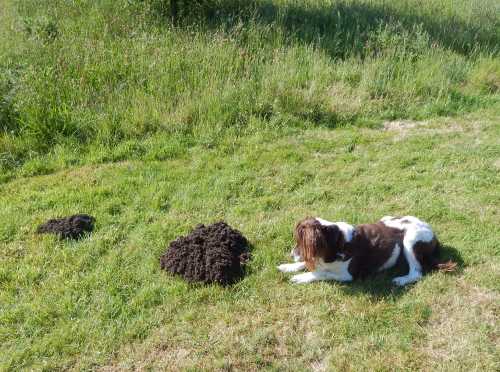 Our spaniel Charlie, supervising a mole hill.
Our spaniel Charlie, supervising a mole hill.Do all bees sting?
If you found this page helpful or interesting, I'd really be grateful if you would share it with others - if not this page, perhaps another, such as Gardening For Bees.
Thank you so much :) .


